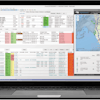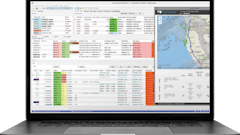The primary purpose of a warehouse management system (WMS) is to manage the overall activity within a warehouse and process the associated transactions, including receiving, putaway, order selection and shipping. A WMS also handles the movement of materials from one location to another, physical inventories and cycle counting.
Although WMS functionality differs from one vendor to another, all address the same basic needs of a warehouse operation. Warehouse management systems often utilize technology such as barcode scanners, radio frequency (RF) terminals, mobile computers, wireless local area networks (LANs), and potentially radio frequency identification (RFID) to monitor the flow of products. Depending on the scope and cost of the WMS, it may include advanced functionality such as cross-docking, labor management, yard management, slotting, transportation management and value-added services. Warehouse management systems can be stand-alone systems or modules of an enterprise resource planning (ERP) system. Benefits claimed include reduced inventory, cost savings, improved space utilization, higher productivity and improved customer satisfaction.
Jerry List, vice president of QC Software, based in Cincinnati, Ohio, devised a list of indicators of when to consider a WCS (warehouse control system). According to List, these are effective statements for supply and demand chain executives to investigate the efficacy of a WCS.
- The current system is inefficient and it takes too long to get an order out the door.
- The company is growing quickly and cannot handle the volume, especially during peak times.
- The conveyor system looks like the freeway during rush hour (cartons everywhere, but going nowhere).
- The company is losing customers to the competition because orders cannot be shipped quickly enough.
- Back-orders are being created even though the product is in stock.
- Products are being lost because there is no visibility of order status.
- Products are being shipping to the wrong place.
- Dealing with multiple material handling equipment vendors is causing support problems.
- The company is concerned that the WMS is remote (off-site) and/or connectivity problems may bring the warehouse operations to a halt.
- Continually modifying the WMS is too expensive.
- The company wants to improve warehouse operations but cannot afford a new WMS or more equipment.
A WCS may help when a company has invested in material handling equipment and software but still has significant operational problems or inefficiencies. A WCS is especially suitable for companies that have high-volume pick, pack and ship operations.
A company that could benefit from a WCS tends to have the following characteristics:
- In excess of $50 million in sales
- Warehouse of 100,000 sq. ft. or greater
- Conveyor system with multiple sortation points
- Multiple "islands" of material handling equipment
- More than an average of three stock-keeping units (SKUs) per order
- Greater than 1,000 orders per day
Table 1: WMS vs. WCS
Smaller companies that do not have automated material handling equipment, or a WMS, may also be able to take advantage of many of the capabilities a WCS has to offer. According to List, "It is possible to use the order fulfillment, inventory control and shipping capabilities without material handling equipment. Smaller companies can also take advantage of advanced techniques such as batch and cluster picking. The WCS will provide manual picking lists and support RF picking."


![Pros To Know 2026 [color]](https://img.sdcexec.com/mindful/acbm/workspaces/default/uploads/2025/08/prostoknow-2026-color.mduFvhpgMk.png?auto=format%2Ccompress&bg=fff&fill-color=fff&fit=fill&h=100&q=70&w=100)






![Pros To Know 2026 [color]](https://img.sdcexec.com/mindful/acbm/workspaces/default/uploads/2025/08/prostoknow-2026-color.mduFvhpgMk.png?ar=16%3A9&auto=format%2Ccompress&bg=fff&fill-color=fff&fit=fill&h=135&q=70&w=240)








